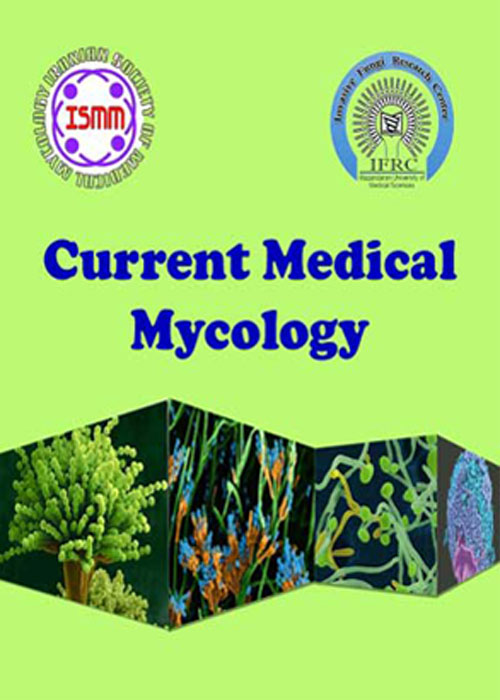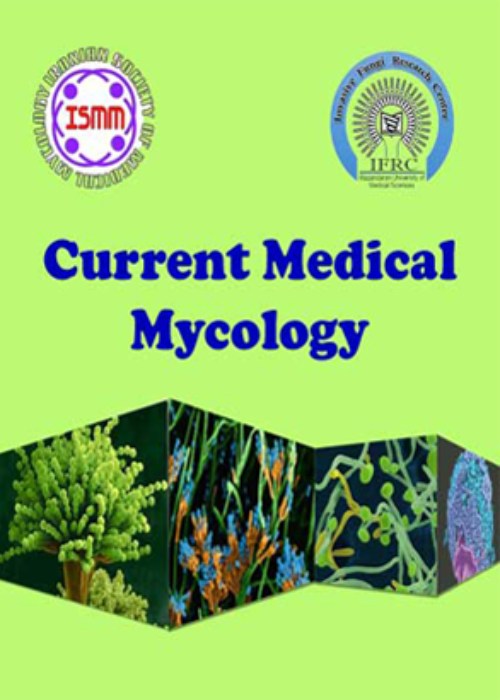فهرست مطالب

Current Medical Mycology
Volume:8 Issue: 1, Mar 2022
- تاریخ انتشار: 1401/05/02
- تعداد عناوین: 7
-
-
Pages 1-6Background and Purpose
Rhinosinusitis (RS) is a clinical and radiological diagnosis that rarely reaches a proper infective etiological diagnosis. The most dreaded fact about invasive fungal rhinosinusitis is its poor prognosis in immunocompromised patients with a 60-80% mortality rate. The present study highlights and compares the various diagnostic techniques to establish a fungal etiological diagnosis in clinically suspected cases of RS from nasal biopsy specimens, with the emphasis on the molecular diagnostic approach.
Materials and MethodsThis prospective study included a total of 34 clinically suspected cases of RS who had recently undergone functional endoscopic sinus surgery (FESS)/biopsy from nasal polyps. Various laboratory methods (microbiological and histopathological) were utilized, including direct microscopic examination of clinical samples and fungal culture isolation. The molecular detection method of polymerase chain reaction (PCR) from clinical samples was also explored simultaneously. Serum immunoglobulin-E (IgE) testing of patients was also performed.
ResultsOut of 34 clinically suspected RS cases, fungal etiology was established in a total of 18 cases, 17 of whom were culture-proven. A total of 15 and 14 culture-proven cases were also detected on direct microscopic examination by potassium hydroxide (KOH) mount and histopathological staining, respectively. One case was additionally identified by molecular method. Aspergillus flavus complex was the most common pathogen isolated in culture. Allergic fungal RS was the most common type, followed by acute and chronic invasive types among all fungal RS cases.
ConclusionAccurate and prompt etiological diagnosis of fungal RS is still lagging with fewer options for quick results. Although microscopy and culture isolation can’t be replaced, PCR is a sensitive and specific method that should be incorporated as a supplementary tool for the early diagnosis and management, considering the delayed growth of fungi.
Keywords: Clinically suspected rhinosinusitis, Fungal rhinosinusitis, Laboratory diagnosis, Molecular detection, Nasal tissue -
Pages 7-11Background and Purpose
Oral candidiasis has become a growing problem in hospitals worldwide, and the development of antifungal drug resistance in Candida species constitutes a serious concern. This study aimed to evaluate the in vitro efficacy of nystatin, and micafungin with chlorhexidine against fluconazole-resistant and fluconazole-sensitive Candida albicans (C. albicans) isolates.
Materials and MethodsIn this experimental-laboratory study, a total of 20fluconazole-resistant (n=10) and fluconazole-susceptible (n=10) C. albicans strains were obtained from the reference culture collection of the Invasive Fungi Research Center in Mazandaran University of Medical Sciences, Sari, Iran. In vitro combination of nystatin and micafungin with chlorhexidine was performed using a microdilution checkerboar method based on the Clinical and Laboratory Standards Institute guideline.
ResultsMicafungin had the highest antifungal activity against C. albicans susceptible and resistant strains, with a Geometric mean of (GM) =0.008µg/ml and GM=0.008µg/ml, followed by nystatin with GM=0.06µg/ml and GM=0.042µg/ml and chlorhexidine with GM=0.25µg/ml and GM=0.165µg/ml against C. albicans resistant and sensitive strains, respectively. The interaction of micafungin and nystatin withchlorhexidine showed a synergistic interaction against most C. albicans strains. Inaddition, no antagonistic interaction was observed between micafungin, nystatin, and chlorhexidine against C. albicans strains.
ConclusionThe synergistic interaction of micafungin with chlorhexidine against azoleresistant C. albicans suggests an alternative approach to overcome antifungal drug resistance. However, further studies are needed for in vivo evaluation. Candida albicans, Chlorhexidine, Combination, Fluconazole, Micafungin,Nystatin
Keywords: candida albicans, Chlorhexidine, Combination, Fluconazole, Micafungin, Nystatin -
Pages 12-19Background and Purpose
Candida albicans (C. albicans) is the most common human pathogen owing to the most virulence factors. It seems that extracellular hydrolytic enzymes play a key role in C. albicans pathogenicity. The present study aimed to assess the susceptibility and enzymatic activity of pathogenic C. albicans isolates exposed to the Syzygium aromaticum (S. aromaticum) essential oil.
Materials and MethodsS. aromaticum oil was characterized using gas chromatography-mass spectrometry (GC–MS). The broth microdilution technique (CLSI, M27-A3) was used to determine the minimum inhibitory concentration (MIC) of test compounds. Furthermore, before and after treatment with S. aromaticum essential oil, the yeasts were analyzed regarding the proteinase (Prz), hemolysin (Hz), and phospholipase (Phz) production/activity.
Resultsβ-caryophyllene (12.76%) was found to be the major constituent in the essential oil after eugenol (84.64%). Only one isolate of C. albicans showed the antifungal resistance to fluconazole. All isolates were susceptible to S. aromaticum essential oil with MIC of 625-1250 μg/ml. S. aromaticum oil represented the best antifungal effectagainst C. albicans at MIC 1000 μg/ml. The mean±SD enzyme activity of C. albicans not exposed to S. aromaticum essential oil was obtained at 0.55±0.03, 0.73±0.04, and 0.61±0.05 for proteinase, hemolysin, and phospholipase, respectively. The activities of these enzymes were reduced significantly (P<0.05) to 0.33±0.06, 0.40±0.04, and0.16±0.03 for phospholipase, proteinase, and hemolysin, respectively, after the yeasts were subjected to S. aromaticum essential oil.
ConclusionThe present study aimed to determine the ability of S. aromaticum essential oil to prevent the growth of C. albicans and decrease their enzymatic activity. As a natural antifungal agent, S. aromaticum can be utilized in pharmaceutical systems.
Keywords: candida albicans, Dianthus caryophyllus, Enzymatic activity, Fluconazole, growth inhibition -
Pages 20-25Background and Purpose
Routine identification of Candida species and knowledge of antibiotic susceptibility patterns can prevent diagnostic delays and help clinicians choose appropriate empirical therapies. This study aimed to identify and speciate Candida isolates from bloodstream infections and evaluate their epidemiological profile and antibiotic susceptibility pattern in a tertiary care hospital in North India.
Materials and MethodsBlood samples were cultured in the Department of Microbiology of a tertiary care hospital from January 2019 to May 2021, and the samples which showed growth of Candida species (spp.) were included in this study.Candida isolates were initially characterized by conventional techniques. Further identification and antifungal susceptibility testing were performed using Vitek 2 compact automated system. Data analysis was performed using the SPSS software (Version 25.0).
ResultsCandida spp. were isolated from a total of 116 blood samples, 60.92% of which belonged to males. The majority (43.10%) of isolates were obtained from 0-1-month-old neonates, followed by infants (16.38%) and children in the age range of 1-17 years (16.38%). Only 6.89% of isolates were obtained from adults older than 18 years. Candida tropicalis (26.72%) was the most common species, followed by Candida pelliculosa (19.83%), Candida albicans (17.24%), Candida parapsilosis (14.66%), Candida famata (9.48%), and Candida krusei (9.48%). Other isolated species included Candida lusitaniae, Candida sphaerica, and Candida inconspicua. Out of 116 isolates,101 isolates were subjected to Vitek 2 susceptibility testing. Overall, 21.78% (22/101) of Candida isolates were found to be resistant/intermediate. Among C. albicans isolates,resistance was observed only against voriconazole (20%) and fluconazole (5%); however, among non- albicans Candida species (NAC), resistance was observed against flucytosine (16.04%), followed by fluconazole (14.81%), voriconazole (3.70%), and caspofungin (3.70%).
ConclusionNon-albicans Candida spp. predominated over Candida albicans in causing bloodstream infections and were found to be more resistant to antifungals.Continuous surveillance is necessary to monitor changes in epidemiological and resistance patterns.
Keywords: Antifungal susceptibility, BLOOD CULTURE, Candida, Candida tropicalis, non albicans Candida -
Pages 26-31Background and Purpose
Taurolidine is active against a wide variety of micro organisms, including bacteria and fungi. Mucormycosis is one of the life-threatening opportunistic fungal infections, especially in immunocompromised patients. Currently, the emergence of Mucormycosis during the COVID-19 pandemic raises public health concerns regarding untoward morbidity and mortality among SARS-CoV-2 patients. It is well-known that delayed and inappropriate antifungal therapy leads to increased morbidity and mortality. This study aimed to investigate the in-vitro antifungal activity of taurolidine to evaluate its effects against clinical isolates of Mucorales.
Materials and MethodsThis study included previously collected clinical Mucorales isolates. The minimum in vitro inhibitory concentration (MIC) of amphotericin B, caspofungin, voriconazole, posaconazole, and itraconazole was determined using the broth microdilution method.
ResultsAll clinical isolates showed full sensitivity to amphotericin B. Posaconazole MIC range from 8 μg/mL to 0.032 μg/mL. The MIC range of voriconazole and caspofungin were determined to be 2-8 µg/mL and 0.5-16 µg/mL, respectively. Growth of the isolates was entirely inhibited in 1000 µg/mL concentration of taurolidine. In microscopic observations, morphological effects on hyphal growth were observed at 500 µg/mL concentration.
ConclusionIn conclusion, this is an updated experience of using taurolidine against Mucorales. However, our in-vitro findings need to be confirmed in well-designed clinical trials aimed at treating invasive Mucormycosis infections.
Keywords: minimum inhibitory concentrations, Mucormycosis, Mucorales, taurolidine -
Pages 32-38Background and Purpose
Candidemia remained important in the intensive care units(ICU) during the COVID-19 pandemic. This study aimed to investigate the clinical and laboratory data on candidemia in COVID-19 patients.
Materials and MethodsThe baseline characteristics, as well as laboratory and clinicalfindings of candidemia and non-candidemia patients, were compared. Candidemia was defined as the isolation of Candida spp. from blood cultures. The isolates were identified by VITEK® 2 (bioMérieux, France) commercial method. Antifungal susceptibility was assessed using the E-test method. Univariate and multiple binary logistic regression analyses were performed to compare the variables.
ResultsIn total, 126 patients with the COVID-19 disease were included. Candidemiawas diagnosed in 44 (35%) of the patients. The number of patients with diabetes mellitus and chronic renal failure was higher in the candidemia group. In the candidemia group, the duration of ICU stay of patients, the 30-day mortality rate, mechanical ventilation therapy, and systemic corticosteroids (Prednisone) usage were significantly higher in candidemia patients. Moreover, the median white blood cell, neutrophils, and lactate dehydrogenase were higher in the candidemia group. Univariate and multiple binary logistic regression analyses were performed to compare the variables. Isolated species were identified as Candida albicans (n=12, 41%), Candida parapsilosis (n=7, 24%), Candida glabrata (n=6, 21%), Candida tropicalis (n=3, 10%), and Candida dublinensis (n=1, 3%). In total, three isolates of six C. glabrata species had dose-dependent sensitivity to fluconazole, and one C. parapsilosis was determined to be resistant.
ConclusionThe COVID-19 patients who are admitted to ICU have many risk factors associated with candidemia. The most common risk factors for the development of candidemia were mechanical ventilation, diabetes mellitus, neutrophilia, and low hemoglobin level. The most frequently isolated species was C. albicans. Moreover, caspofungin was found to be the most effective drug in vitro. No significant resistancepattern was detected against the isolated species. It should be noted that risk-stratified antifungal prophylaxis in the ICU is possible.
Keywords: COVID-19, Candidemia, Intensive Care Unit, Risk factor -
Pages 39-43Background and Purpose
Disseminated fusariosis is an opportunistic infection caused by the hyaline fungus Fusarium spp. and occurs mainly in patients with leukemia.
Case reportTwo cases of disseminated fusariosis in pediatric patients are presented.Profound and prolonged neutropenia, fever, myalgia, and skin lesions in the legs werepresent in two girls with leukemia undergoing chemotherapy. In the first case, infectionby Fusarium spp. was confirmed by anatomopathological findings, pathogen isolation, and polymerase chain reaction. In the second case, Fusarium solani infection was confirmed by mass spectrometry using blood cultures and skin lesion samples.
ConclusionIt is important to consider disseminated fusariosis in high-risk patients who present with profound and prolonged neutropenia and persistent fever that does not resolve after broad-spectrum antibiotics to initiate antifungal therapy in a timely manner.
Keywords: Fusarium spp, Invasive fungal infection, Leukemia, neutropenia


